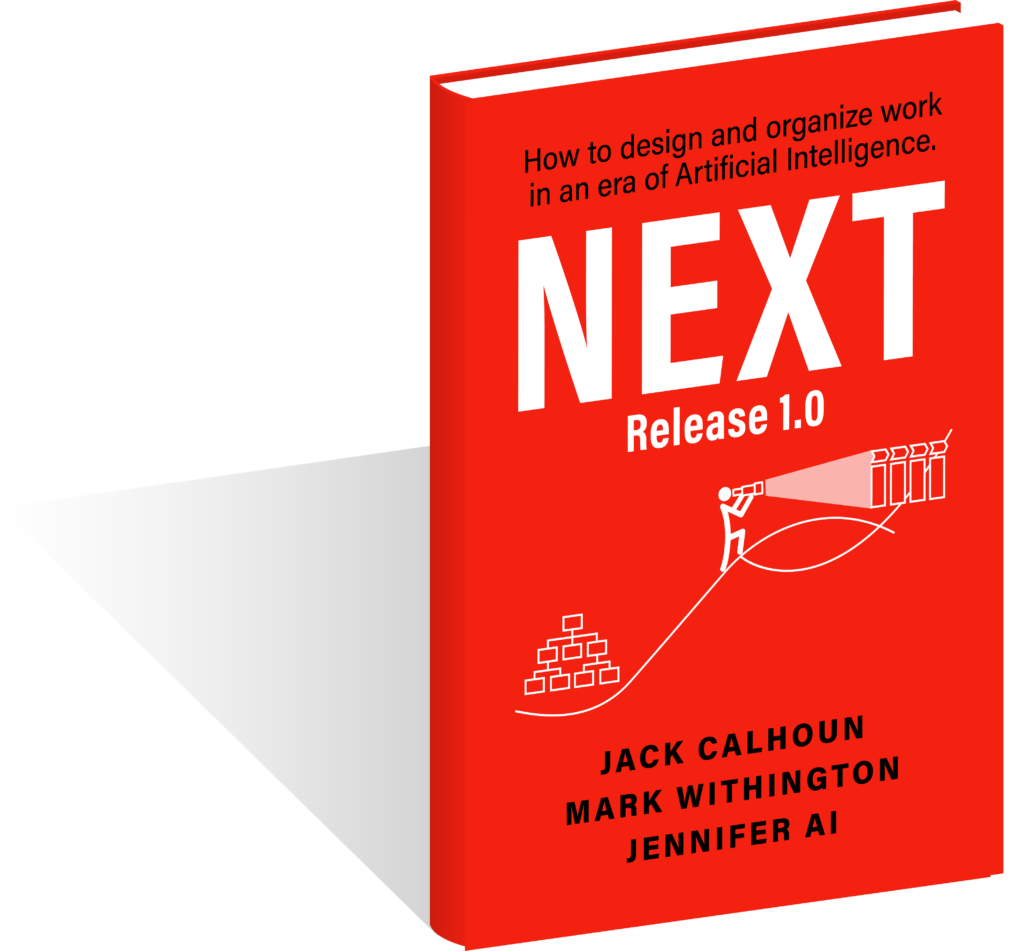“How to design and organize work in an era of Artificial Intelligence”

Hear what others are saying about the book
Meet the Authors
Jack Calhoun, Mark Withington, with help from Jennifer Ai
Accelare’s CEO, Jack Calhoun and Vice President, Mark Withington, supported by research from Jennifer Ai (a sophisticated language model), unveil a groundbreaking approach leaders must embrace in their struggle to capitalize on the AI fueled world of digital transformation.
In Next, we challenge the conventional wisdom that the org-chart is the cornerstone of strategic planning. We argue this reliance is a profound misstep, as it forces a tool never intended for strategic planning to dictate how a company approaches its markets, customers, and the very resources it needs to succeed.
Furthermore, we argue that the annual budgeting process, driven by the org-chart’s departmental structure, fragments an organization’s strategy and customer journeys into siloed optimizations, inadvertently reinforcing the status quo instead of driving innovation.
Next outlines four new business principles starting with reengineering the strategic planning process; and in doing so introduces the High Definition Operating Model which explicitly defines how the organization designs, prepares for, and delivers it value proposition to its customers.
What’s “NEXT”

This books stands on the shoulders of giants in a literal sense. Business best sellers such as “Reengineering the Corporation” (Hammer & Champy), “The Innovator's Dilemma” (Christensen), “Good to Great” (Collins), “Blue Ocean Strategy” (Kim & Mauborgne), and Scrum: The Art of Doing Twice the Work in Half the Time (Sutherland) set the stage for the NEXT big idea in business strategy and management. Indeed, the title, “NEXT” is intended to be a double entendre expressing our desire for it to not only become the next book in a series of business best sellers that CEOs and their staff will consider mandatory read, but also the approach in which organizations can reinvent themselves to address the needs of their NEXT business model and opportunity.
We are at the dawn of a new age of work – the augmented-age – where the current frenzy of tactical AI-enablement will give way to new strategic models of augmented work. Where we will no longer talk about the “digital disruption” of AI with the same level of anxiety and uncertainty; instead, we will navigate a world where the lines between humans and AI and work will become increasingly integrated. This will not be the dystopian future of sentient machines and human obsolescence that science fiction once warned us about. Instead, it will be a world of augmentation and trained AI agents where human ingenuity, judgement, ethics and work processes are supported and amplified by the tireless learning and processing power of AI.
The global economy is in constant flux, with industries evolving and shifting across borders. For example, manufacturing, once a cornerstone of developed economies has largely migrated to less developed ones. This trend is evident in countries like the US, where, according to the Bureau of Labor Statistics, manufacturing employment has declined from its peak in 1979, while the service sector now accounts for roughly 80% of GDP (Bureau of Economic Analysis).
Let’s put some numbers against those statistics. In the US, the mix of industries has shifted dramatically. Over the last 20 years, the U.S. has lost more than 45,000 manufacturing firms amid evolving global trade dynamics, labor arbitrage and a focus on automating once manual, labor-intensive tasks.
We’ve all heard Silicon Valley’s claims that “this new XYZ technology will obsolete your current business model if you don’t adopt it right now”. The tech sector is famous for pumping up the hype of their latest “transformational” technology: the ERP promises of the 1990’s, the dotcom promises of the early 2000, mobile computing, big data and analytics, cloud computing and Software as a Service promises of late, block chain, IOT, bit coin, PaaS and now artificial intelligence.
The era of Digital Disruption is rapidly reshaping industries, markets, and customer expectations. To understand this disruption, it is essential to examine the foundations upon which it is built: the knowledge economy.
The term “knowledge economy” emerged in the late 20th century, reflecting knowledge as a primary economic driver. Similar to how land, labor, and capital propelled the Industrial Revolution, knowledge has become the driving force behind economic growth in the digital age. Visionaries like Peter Drucker and Fritz Machlup anticipated a society where knowledge workers and intellectual capital would play a significant role.
Peter Drucker, often referred to as the “father of modern management,” emphasized human values and ethics in management. He introduced concepts like “management by objectives” (MBO), promoting collaboration between managers and employees to achieve shared goals. He also highlighted the importance of innovation, knowledge work, and decentralization.
Back in 1994, Jack worked for the Index Group who helped start the Reengineering movement supporting MIT’s Michael Hammer and James Champy with the research and field work that formed the principles of Reengineering and the best-selling book, Reengineering the Corporation.
The book coined the term and put forth a formal definition of Reengineering as “the fundamental rethinking and radical redesign of business processes to achieve dramatic improvements in critical contemporary measures of performance, such as cost, quality, service and speed”
There are four key words in this definition.
- The first key word is “fundamental” – in doing reengineering, leaders must ask the most basic questions about their companies and how they operate; Why do we do what we do? And why we do it the way we do it?
- The second key work is “radical”. Radical redesign means getting to the root of things; not fixing or improving what you have already in place. Reengineering is about business reinvention, transformation – not business improvement or quality or lean.
In the preceding chapter, we explored the limitations of traditional strategic planning and the pressing need for a more integrated approach that harmonizes an organization’s value proposition(s), business model(s), and operating model. The inherent misalignment between these elements, often exacerbated by a reliance on outdated tools like the org chart, hinders organizations from effectively adapting to the rapidly changing and increasingly digital business landscape.
Recall that the three elements which the strategy process must synchronize are:
- The Value Proposition which must change regularly (annually) to stay-ahead of competitors and substitute products and services,
- The As-Is and To-Be Business Models – which enables us to design, build and deliver our current and future generations of our value proposition; the products, services and experiences we offer. There are always at two “generations or models in play” the As-Is and To-Be
- The In-Market Operating Model which is in production, in the market and which must generate the operating performance (profit and loss and balance sheet) to enable us to afford the strategic agenda set out before us in the value proposition and business model changes as we move through the cycles of creative destruction.
The last time you bought health insurance, financial services, a flatscreen TV, a driver’s license, a car, or for that matter any product or service, did you feel like your customer journey was well designed and mapped out? Or did you feel like a customer experience pioneer “boldly going where no customer had gone before”?
Customer Experience – the compilation of thoughts and emotions a prospective customer, new customer, or existing customer perceives at each interaction with the cooresponding organization is the conduit for delivering value through the Hi-Def Operating Model. One would think, therefore, the organization’s Customer Experience design and delivery processes would rank amongst its highest priorities. And yet for many of those organizations, the customer experience is vaguely defined and controlled, relying instead upon the tribal knowledge and heroics of frontline personnel to patch-up any inconsistencies and fumbled handoffs along the way. It spans many departments and therefore is noone’s responsibility – putting the customer in the middle.
Technology has evolved from an enabler of automation to a powerful transformer, it is being used to reshape business models, redefine customer experiences, and fuel innovation at an unprecedented pace. As Klaus Schwab eloquently stated in “The Fourth Industrial Revolution,” we stand on the brink of a technological revolution that will fundamentally alter the way we live, work, and relate to one another”.
This revolution is not merely about adopting the latest gadgets, automating existing processes or bolting these technologies onto your existing business model; it’s about using generative AI to redesign how organizations operate, create value, and deliver exceptional customer experiences. It’s about harnessing the transformative power of technology to build a future state operating model not automating a legacy one.
As stated earlier, conventional approaches to strategy formulation lack the means of cohesive execution, opting instead to parse and bestow that responsibility to the functional departments within the org chart. To address this shortcoming, we have encapsulated the four principles described earlier into a concise three-phase methodology that we call Envision, Create, and Operate.
This chapter will delve into all three phases starting with the first phase of this approach, “Envision”. This stage is about setting the compass for your organization, defining a clear and compelling vision for the future. In this fast-paced world, envisioning is not about predicting the future but rather creating it. It’s about identifying emerging opportunities, anticipating potential disruptions, and charting a course towards sustainable growth. We’ll discuss the importance of cultivating a strategic mindset, fostering a culture of innovation, and developing a deep understanding of your customers and the broader market landscape in order to establish a unique value proposition and supporting business models. And a clear, concise case for action to begin the transformational journey.
Governance provides the framework of rules, processes, and structures that guide decision-making, ensure accountability, and steer an organization towards its strategic goals. It acts as a compass, keeping the ship on course even in turbulent markets.
However, traditional governance models, often symbolized by rigid org charts, have become obstacles in both the public and private sectors. In the private sector, they overemphasize internal hierarchies and structures at the expense of the customer experience. In the public sector, this translates to prioritizing internal bureaucracy over constituent needs and expectations.
Both sectors need a new model—a high-definition operating model that utilizes a matrixed approach, mapping process families with traditional governance structures. This creates both an internal and external framework that fosters short- and long-term growth. In the private sector, this leads to business model transformation aligned with customer needs and market demands. In the public sector, it results in aligning processes with the executive office agenda and legislative priorities.
Navigating the transition to a Hi-Def Operating Model demands more than just structural changes; it necessitates a profound cultural shift, and it starts at the top. The CEO and Executive Leadership team must lead, meaning they deeply believe in this Next model of work and master these techniques themselves. This chapter delves into the complexities of organizational change management (OCM) to make that shift, emphasizing the need to evolve beyond traditional approaches and embrace a transformative mindset. We’ll explore how to leverage the Hi-Def Operating Model’s principles to drive change, address resistance, empower employees, and ultimately achieve sustainable success in the digital age. Key takeaways will include understanding the critical role of leadership, the power of the budget as a change lever, the importance of addressing cognitive biases, and the strategic use of the Change Matrix to facilitate a smooth and effective transformation.
In the preceding chapters, we’ve explored how organizations can leverage the Hi-Def Operating Model to streamline their operations, enhance customer experiences, and ultimately achieve sustainable success. We’ve dove deep into the intricacies of defining, building, and delivering value, focusing primarily on the customer-facing aspects of the business.
However, behind the scenes, exists a network of processes that, while not directly interacting with the organization’s customers, are indispensable to the smooth functioning of any organization. These processes are orchestrated by the IT professionals who maintain the intricate technological infrastructure, the HR specialists who nurture and develop talent, the finance experts who safeguard the organization’s financial health, and the facilities teams who create a conducive work environment. We refer to these as enabling processes and corporate services. These are businesses within the business. They have customers (albeit internal), they have services, and they should have all have a vision, strategy, and operating model.
“The ultimate measure of a man is not where he stands in moments of comfort and convenience, but where he stands at times of challenge and controversy.” These words from Dr. Martin Luther King Jr. ring true not only for individuals but also for nations. The United States, with its sprawling economy and complex political landscape, has faced its share of challenges and at the heart of these challenges lies a fundamental question: What role should the government play in the economy?
One way to gauge this role is by looking at the percentage of the nation’s Gross Domestic Product (GDP) attributed to government spending. GDP is the total value of goods and services produced within a country’s borders in a specific time period. It’s a broad measure of economic activity, and the portion consumed by government expenditure provides insight into its involvement.
We will finish as we started. We are at the dawn of a new age of work – the augmented age. This initial frenzy of AI-enabled digital transformation will give way to new models of work – the traditional functional org chart model itself will be augmented by a new Hi-Def, AI-powered model of work a model where human ingenuity, judgement, ethics and work processes are supported and amplified by the tireless learning and processing power of AI.
The authors talk about aspects of the book as they apply to current events and new technology.

